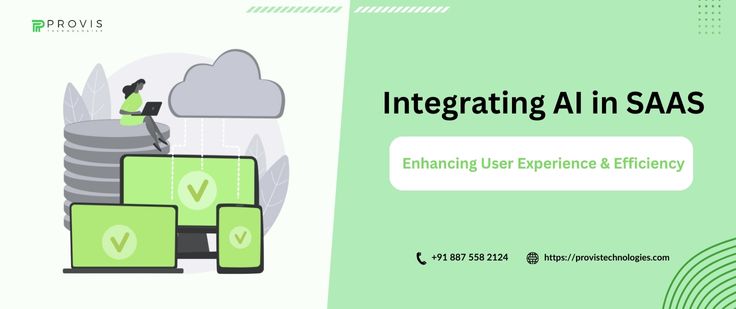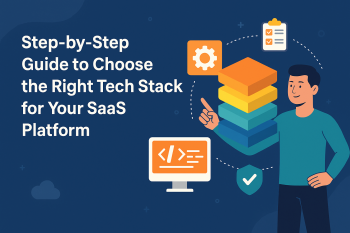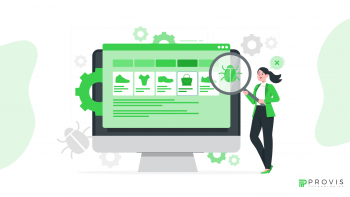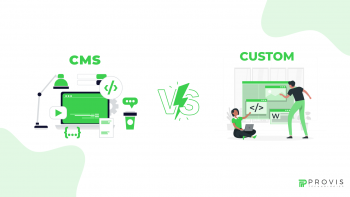AI & SaaS have both been very popular & helpful in recent times. Both have their unique qualities & capabilities. And to take their benefits to the next level – people are now starting to combine and use them as one. This helps maximize their potential and allows businesses to extract the most in less investment. Recently, the integration of AI in a SaaS environment has emerged as a game-changer. AI’s transformative capabilities have propelled SaaS platforms beyond mere productivity tools, inaugurating a new era of extraordinary user experience & workflow efficiency. From predictive analytics to personalized recommendations, this fusion of AI in SaaS empowers businesses to serve the best in today’s rapidly evolving digital world.
Before we proceed, let’s look at some current stats on AI in SaaS.
Key Statistics on Integrating AI in SaaS
User Satisfaction
According to Gartner, SaaS platforms integrating AI experience a 20% increase in user satisfaction.
Operational Efficiency
Businesses leveraging AI in SaaS witness up to a 40% improvement in operational efficiency, reports McKinsey & Company.
Revenue Growth
SaaS companies incorporating AI experience a 30% increase in revenue growth compared to their counterparts, states Deloitte’s AI in SaaS report.
Cost Savings
IBM’s AI Impact report suggests organizations adopting AI in SaaS have seen up to a 30% reduction in operational costs.
Understanding AI in SaaS
At its core, AI (Artificial Intelligence) empowers machines to mimic human intelligence, enabling them to analyze data, recognize patterns, and make informed decisions autonomously. In the context of SaaS (Software as a Service), AI algorithms leverage vast datasets to automate tasks, anticipate user needs, and deliver personalized experiences in real-time. This symbiotic relationship between AI and SaaS lays the foundation for a more intuitive, responsive, and efficient software ecosystem – which we here are calling AI in SaaS.
Also Read:- Know How to Choose the Right SaaS Development Company
Why AI in SaaS?
AI in SaaS is not any fancy trend, but it’s a revolution reshaping workflow technology. Businesses are rapidly turning to AI-powered SaaS solutions to gain a competitive edge. The rationale behind this shift lies in the transformative capabilities of AI & SaaS to elevate user experience, drive operational efficiency, and unlock new growth opportunities.
Better Services
AI enhances user experience & services by personalizing interactions, anticipating needs, and delivering proactive support. From intelligent chatbots to recommendation engines, AI-powered features streamline workflows, minimize friction, and foster smooth engagement with SaaS platforms.
Workflow Enhancement
AI drives operational efficiency by automating repetitive tasks, optimizing processes, and extracting actionable insights from vast datasets. By harnessing the power of AI-driven analytics, businesses can make data-driven decisions, mitigate risks, and identify new revenue streams more effectively.
Faster Processing
AI in SaaS enables organizations to stay agile and responsive to market dynamics. Whether it’s about adapting to changing customer preferences or anticipating industry trends, AI empowers businesses to innovate & stay ahead of the competition in today’s digital-first world.
Potential Challenges of AI in SaaS
While AI-SaaS integration brings numerous benefits, it presents several potential challenges businesses must navigate to maximize effectiveness.
Data Protection
With the vast amounts of sensitive data being processed & analyzed, ensuring robust data protection measures is essential to prevent unauthorized access, breaches, and regulatory compliance issues.
Manipulation Risks
If algorithms are trained on biased datasets, they may perpetuate or exacerbate existing biases, leading to unfair outcomes & discrimination. Mitigating algorithmic bias requires careful scrutiny of data sources, transparency in algorithmic decision-making, and ongoing monitoring to evade manipulation risk.
Management Issues
The complexity of implementing & managing AI in SaaS can be daunting for some organizations, especially those lacking the necessary expertise. From selecting the right AI technologies to integrating them into existing infrastructure, navigating the AI landscape requires a concerted effort in team skill building to handle things.
Workforce Disruption
AI in SaaS raises concerns about job displacement and human workforce disruption. While AI can automate routine tasks and augment human capabilities, it also has the potential to disrupt traditional job roles. Businesses must figure out this issue because no matter how smart, any technology can never replace the human workforce – it can just support.
Don’t Miss:- How Will AI Affect the Design of UI/UX?
How to Integrate AI in SaaS?
Integrating AI into SaaS requires a strategic approach to leverage its transformative capabilities effectively. Here’s the complete process to follow for AI in SaaS:
Identify Use Cases
Identifying specific use cases where AI can add value to your SaaS platform is the first thing to be done. Whether it’s about enhancing user experience, optimizing operations, or driving innovation – clarity on use cases is crucial for prioritizing AI integration efforts.
Data Preparation
Ensure access to high-quality, relevant data to train AI algorithms effectively. Cleanse, preprocess, and annotate datasets to minimize noise and biases to ensure that AI models deliver accurate & reliable results.
Select AI Technologies
Choose AI technologies and frameworks that align with your use cases and technical requirements. Whether it’s machine learning, natural language processing, or computer vision – selecting the right AI tools is essential for success.
Develop AI Models
Develop & train AI models using selected algorithms & techniques. Leverage supervised, unsupervised, or reinforcement learning approaches to build models that can analyze data, make predictions, and automate tasks effectively.
Hire an Agency
Hiring a good IT agency like Provis Technologies is one of the best ways to get things done. They have experience, resources, & skilled team to integrate AI into SaaS.
Integration with the SaaS Platform
Leverage APIs, SDKs, or custom integrations to embed AI-driven features and functionalities into existing workflows and user interfaces.
Testing & Validation
Thoroughly test and validate AI models to ensure accuracy, performance, and reliability in real-world scenarios. Conduct extensive testing across diverse datasets and edge cases to identify and address potential issues before deployment.
Iterative Improvement
Continuously monitor and refine AI models based on feedback and performance metrics. Embrace an iterative approach to AI development, incorporating new data and insights to enhance model accuracy and effectiveness over time.
Must Know:- SaaS Trends 2024: What’s Next in Development?
Bottom Line
The integration of AI in SaaS represents a shift in businesses leveraging technology to enhance the system. By harnessing the power of AI-driven insights, automation, and personalization, SaaS platforms are redefining industry standards and empowering businesses to thrive in the digital age. As AI continues to evolve, its fusion with SaaS will unlock new possibilities and shape the future of work.
FAQs
How does AI enhance user experience in SaaS?
AI enhances user experience in SaaS by analyzing user behavior, preferences, and interactions to enable personalized interfaces, proactive support, and streamlined workflows.
What role does AI play in optimizing operational efficiency in SaaS platforms?
AI automates repetitive tasks, optimizes workflows, and provides actionable insights – resulting in improved operational efficiency by up to 40%.
Can AI in SaaS improve customer satisfaction?
Yes! AI-driven features like intelligent chatbots & recommendation engines contribute to a 20% increase in user satisfaction, fostering deeper engagement and loyalty.
What challenges are associated with integrating AI into SaaS?
Challenges include data privacy concerns, algorithmic bias, and the need for skilled AI talent, requiring careful navigation for ethical AI deployment and risk mitigation.
How can businesses identify suitable AI use cases for their SaaS platforms?
Businesses can identify AI use cases by clarifying areas where AI can add value, such as enhancing user experience, optimizing operations, or driving innovation.
How can AI be integrated into SaaS?
There are plenty of ways to do this – the most effective way is to hire a top IT agency like Provis Technologies. In this case, you will have no need to worry about anything – second, there will be no chances of errors. These agencies can be connected by their websites.
Written By
Author's Picks
- Remote SAAS Operations
- 07/02/2024
- Know How to Choose the Right SaaS Development Company
- 17/11/2023
- Everything You Need to Know about SaaS E-commerce Platforms
- 27/03/2024
Categories
- AI for Startups
- AI in Web Development
- AI Integration
- AI Platforms
- AI Prompt
- AI Tools
- AI Trading Software
- Android App
- Android vs iOS Development
- Angular
- API
- API Development
- App
- app development
- App Idea
- App User Feedback
- Application
- Artificial Intelligence
- Audit Services
- Automotive Industry
- Awards and Recognition
- Business Consulting
- Business Website
- Chatbots
- CRM
- CRM for Financial Advisors
- Custom CRM
- Custom SaaS
- Custom Website
- Customer Service
- dashboard design
- Developing a Mobile App
- Digital Business
- E-commerce
- EMR Integration
- Finance
- Financial Advisors
- Financial Advisors
- GIT
- Health Insurance
- iOS App
- iOS App Development
- IoT Mobile App Development
- IoT Platforms
- IT Audit Services
- IT Consulting
- IT Strategies
- Java Development
- Laravel
- Lean Canvas
- Learning Management System
- Logistics Apps
- Mobile App Development
- MVP
- Native App
- News Aggregator Site
- OTT
- Outsourcing IT
- Payment Gateway
- predictive analysis
- Product Launch Strategy
- Progressive Web App (PWA)
- Prototype
- Recommender Systems
- Ruby
- SaaS
- SaaS Application
- SaaS Business
- SaaS Company
- SaaS Development
- SaaS Product
- SaaS Project
- Sales Funnel
- SEO
- Shopping Cart
- Software Development
- SSL and TLS
- Startup Checklist
- Technology
- Tetradic Color Scheme
- UI/UX Design Company
- Unit Testing
- User Flow
- User Testing
- Web Development
- Web Performance Optimization
- website Maintenance Services
- Website Migration Service
- Website Speed Optimization
- WooCommerce
- WordPress





